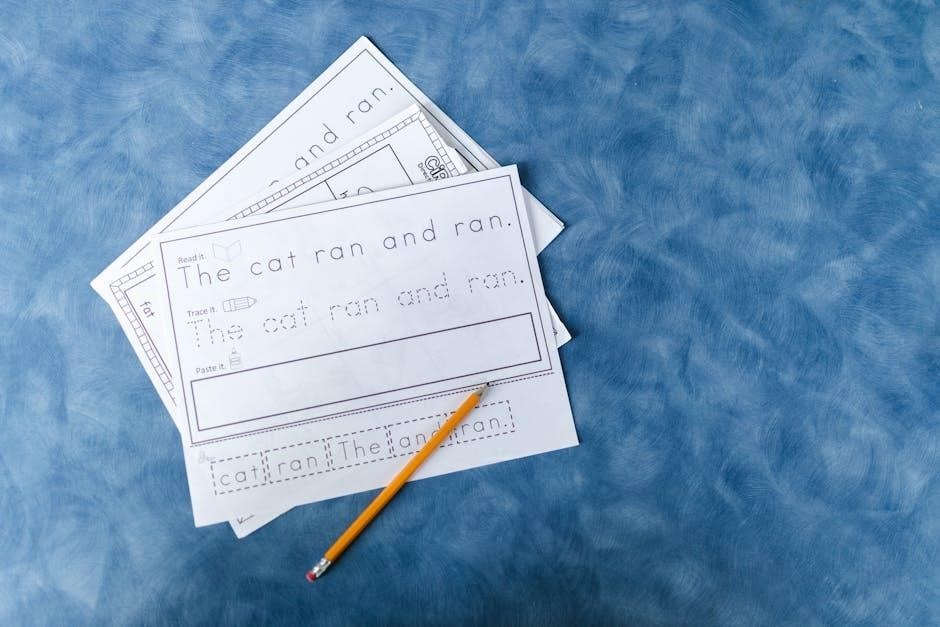Dissociation is a mental process where individuals disconnect from their thoughts, feelings, or surroundings, often as a coping mechanism for trauma or stress. Worksheets help identify triggers, emotions, and physical sensations, aiding in self-awareness and emotional regulation. They are essential tools for managing dissociative episodes and fostering healing in mental health contexts.
1.1 What is Dissociation?
Dissociation is a mental process where individuals experience a disconnection from their thoughts, feelings, or surroundings. It often serves as a coping mechanism, helping people escape overwhelming stress or trauma. This detachment can manifest as feeling disconnected from oneself, observing events as if from outside the body, or experiencing memory gaps. Dissociation can be acute or chronic, and it is commonly linked to traumatic experiences. While it provides temporary relief, it can hinder emotional processing and interfere with daily life. Understanding dissociation is crucial for addressing its impact and developing strategies to manage it effectively, which is where tools like dissociation worksheets become invaluable.
These worksheets guide individuals in identifying triggers, emotions, and physical sensations associated with dissociative episodes, fostering greater self-awareness and control.
1.2 Understanding Dissociation Worksheets
Dissociation worksheets are structured tools designed to help individuals identify and manage dissociative episodes. These worksheets typically include sections for documenting triggers, emotions, physical sensations, and behavioral reactions. They guide users in reflecting on their experiences, providing insight into patterns and underlying causes of dissociation. By encouraging self-reflection and awareness, these worksheets empower individuals to better understand their coping mechanisms and develop strategies for grounding and emotional regulation. They are often used in therapeutic settings to support trauma recovery and enhance mental health outcomes. Regular use of dissociation worksheets can lead to improved self-awareness and more effective management of dissociative symptoms, ultimately fostering personal growth and healing.
1.3 Importance of Dissociation Worksheets in Mental Health
Dissociation worksheets play a crucial role in mental health by providing individuals with practical tools to manage dissociative symptoms. They help individuals process traumatic experiences, identify triggers, and develop coping strategies. These worksheets are particularly beneficial for those with PTSD, childhood trauma, or complex trauma, as they offer a structured way to explore emotions, thoughts, and physical sensations. By fostering self-awareness and emotional regulation, dissociation worksheets empower individuals to regain control over their mental health. They are also valuable in therapy sessions, enabling therapists to track progress and tailor interventions. Overall, dissociation worksheets are essential for promoting healing, resilience, and long-term mental well-being in individuals struggling with dissociation.

Benefits of Using Dissociation Worksheets
Dissociation worksheets enhance self-awareness, improve emotional regulation, and facilitate trauma recovery. They strengthen coping mechanisms, helping individuals process dissociative episodes and reconnect with their thoughts, feelings, and surroundings effectively, promoting mental healing and resilience.
2.1 Enhancing Self-Awareness
Enhancing self-awareness is a cornerstone benefit of dissociation worksheets, enabling individuals to recognize patterns in their thoughts, emotions, and physical sensations. By documenting dissociative episodes, users gain insight into triggers and reactions, fostering a deeper understanding of their mental processes. These tools encourage reflection on how dissociation impacts daily life, helping individuals reconnect with their experiences. The structured format of worksheets promotes accountability and mindfulness, allowing users to track progress over time. This heightened self-awareness is crucial for managing dissociation effectively, as it empowers individuals to identify early warning signs and implement grounding techniques. Ultimately, dissociation worksheets serve as a catalyst for personal growth, helping individuals develop a stronger connection to their identity and emotions.

2.2 Improving Emotional Regulation
Dissociation worksheets play a vital role in improving emotional regulation by helping individuals recognize and manage their emotional responses during dissociative episodes. These tools guide users to identify triggers and explore the emotions experienced during dissociation, fostering a better understanding of their emotional landscape. By documenting emotional patterns, individuals can develop strategies to modulate their responses, reducing the intensity of overwhelming feelings. Worksheets often include grounding techniques, which help bring individuals back to the present moment, enhancing emotional stability. Regular use of these tools encourages mindfulness and self-compassion, enabling individuals to process emotions more effectively. Over time, this leads to improved emotional resilience and the ability to navigate dissociative episodes with greater ease and awareness.
2.3 Facilitating Trauma Recovery
Dissociation worksheets are invaluable tools for facilitating trauma recovery by providing a structured way to process and integrate traumatic experiences. These worksheets help individuals identify triggers and explore the emotions, thoughts, and physical sensations associated with dissociative episodes. By documenting these experiences, users gain insight into patterns of dissociation, allowing them to address unresolved trauma more effectively. Grounding techniques included in the worksheets assist individuals in regaining control during dissociative episodes, promoting emotional stability. Regular use of these tools fosters self-awareness and encourages the reintegration of fragmented memories, helping individuals move beyond trauma. Over time, dissociation worksheets empower users to rebuild their sense of self and achieve lasting healing.
2.4 Strengthening Coping Mechanisms
Dissociation worksheets play a crucial role in strengthening coping mechanisms by providing practical tools to manage dissociative episodes. These worksheets guide users to identify triggers, explore emotional responses, and document physical sensations, helping them develop strategies to stay grounded. By practicing grounding techniques, individuals can reduce dissociation and improve emotional resilience. The structured exercises in the worksheets encourage users to reflect on their experiences, fostering a better understanding of their coping patterns. Over time, this process enhances their ability to manage stress and trauma effectively, promoting long-term emotional stability and well-being. Strengthening these mechanisms is essential for individuals to regain control over their mental health journey.

Structure of a Dissociation Worksheet
A dissociation worksheet typically includes sections for identifying triggers, assessing emotional responses, exploring thought patterns, documenting physical sensations, and reflecting on behavioral reactions to promote self-awareness and healing.
3.1 Identifying Triggers
Identifying triggers is a crucial component of dissociation worksheets, helping individuals recognize specific thoughts, emotions, or events that lead to dissociative episodes. By documenting these triggers, users can gain insight into patterns and develop strategies to manage or avoid them. Worksheets often include prompts to list triggers, such as traumatic memories, stressful situations, or sensory stimuli. Understanding these triggers allows individuals to anticipate and prepare for potential dissociative episodes, enhancing their ability to stay grounded and maintain emotional stability. This section encourages users to reflect on past experiences and connect them to their dissociative responses, fostering greater self-awareness and control. Over time, this process can reduce the frequency and intensity of dissociation, aiding in overall mental health recovery.
3.2 Assessing Emotional Responses
Assessing emotional responses in dissociation worksheets involves exploring and documenting the feelings experienced during dissociative episodes. This section helps individuals identify and process emotions, such as anxiety, fear, or numbness, that may arise in response to triggers. By rating the intensity of emotions or describing them in detail, users gain clarity on their emotional states. Worksheets often include prompts to reflect on how emotions shift during dissociation and how they impact daily functioning. Understanding these emotional patterns can enhance self-awareness and provide insights into underlying trauma or stressors. This process also aids in developing healthier emotional regulation strategies, which are critical for managing dissociation and promoting long-term mental well-being.
3.3 Exploring Thought Patterns
Exploring thought patterns in dissociation worksheets helps individuals identify and understand the cognitive processes occurring during dissociative episodes. This section encourages users to examine their thoughts, beliefs, and assumptions that arise when dissociating. By documenting these thoughts, individuals can recognize patterns, such as negative self-talk or unrealistic fears, that may contribute to dissociation. Worksheets often include questions about the content of thoughts, their perceived validity, and how they relate to past experiences. This process fosters self-awareness and allows individuals to challenge unhelpful thought patterns. Understanding and reframing these thoughts can reduce their intensity and frequency, promoting emotional regulation and resilience. This exploration is a key step in managing dissociation and improving mental health outcomes.
3.4 Documenting Physical Sensations
Documenting physical sensations in dissociation worksheets helps individuals track bodily reactions during dissociative episodes. Common sensations include numbness, tingling, tension, or pain. By recording these, users can identify patterns linking physical symptoms to emotional or environmental triggers. This section often includes prompts like “Where in your body do you feel discomfort?” or “Describe any changes in temperature or pressure.” Understanding these sensations provides insights into how dissociation manifests physically, aiding in early recognition of episodes. This documentation also supports grounding techniques by helping individuals reconnect with their body. Over time, it enhances awareness of physiological responses, fostering better emotional regulation and coping strategies. This practice is crucial for managing dissociation effectively and improving overall mental health outcomes.
3.5 Reflecting on Behavioral Reactions
Reflecting on behavioral reactions in dissociation worksheets involves examining actions taken during or after dissociative episodes. This helps identify patterns, such as avoidance, withdrawal, or impulsive behaviors. By documenting these reactions, individuals can better understand how dissociation influences their behavior and decision-making. Worksheets often include questions like, “What did you do during the episode?” or “How did your actions align with your emotions?” This reflection fosters accountability and insight, enabling individuals to recognize how their behaviors may perpetuate or alleviate dissociative symptoms. Over time, this practice can lead to more adaptive responses to triggers, improving emotional and psychological well-being. It also supports therapy by providing a clear record of progress and areas for further exploration.

How to Use a Dissociation Worksheet
A dissociation worksheet guides individuals to identify triggers, document emotions, and practice grounding techniques. Regular use helps track progress and manage dissociative episodes effectively over time.
4.1 Step-by-Step Guide
Begin by identifying triggers and documenting emotions experienced during dissociative episodes. Next, record physical sensations and thoughts associated with the event. Reflect on the experience, noting patterns or recurring themes. Practice grounding techniques, such as deep breathing or sensory focus, to reconnect with the present. Review and revise responses to track progress over time. This structured approach helps individuals gain insights into their dissociative experiences and develop coping strategies to manage them effectively. Regular use of the worksheet fosters consistency and supports long-term mental health improvement.
4.2 Identifying Dissociative Episodes
Identifying dissociative episodes involves recognizing moments when you feel disconnected from your thoughts, emotions, or surroundings. Use the worksheet to document triggers, such as specific events or sensory inputs, that may lead to dissociation. Note the emotions experienced during these episodes, such as numbness, confusion, or detachment. Record physical sensations, like dizziness or tingling, to better understand your body’s response. Reflect on recurring patterns or themes in these episodes to identify underlying causes. This process helps you become more aware of your dissociative experiences and how they manifest, enabling you to develop strategies to manage and reduce their impact on daily life.
4.3 Reflecting on Dissociative Experiences
Reflecting on dissociative experiences involves examining the thoughts, emotions, and sensations that occurred during an episode. Use the worksheet to explore what happened before, during, and after dissociation, such as triggers or environmental factors. Consider how dissociation affected your ability to engage with your surroundings or connect with others. Note any patterns in your responses, such as recurring emotions or physical sensations. Reflect on how dissociation impacts your daily life and relationships. This reflection helps you understand the root causes of dissociation and its effects, enabling you to develop targeted strategies for managing future episodes and improving emotional resilience.
4.4 Practicing Grounding Techniques
Grounding techniques are essential for managing dissociative episodes by helping individuals reconnect with their present environment. Common techniques include deep breathing, sensory exercises, or physical activities like walking barefoot. The worksheet may guide users to practice grounding by focusing on five things they can see, four they can touch, three they can hear, two they can smell, and one they can taste. These exercises help reduce dissociative symptoms by anchoring the individual in the moment. Regular practice of grounding techniques can improve emotional stability and reduce feelings of detachment, providing immediate relief during dissociative episodes and enhancing overall mental well-being.
4.5 Reviewing and Revising Responses
Reviewing and revising responses in a dissociation worksheet is crucial for tracking progress and identifying patterns in dissociative episodes. By revisiting entries, individuals can gain insights into recurring triggers and emotional responses, allowing them to refine their coping strategies. This reflective process fosters a deeper understanding of their experiences and enhances self-awareness. Revisions also provide an opportunity to explore new grounding techniques or emotional regulation methods, ensuring the worksheet remains a dynamic tool for mental health management. Regular review helps individuals acknowledge improvements and address areas needing further attention, promoting a more proactive approach to managing dissociation and supporting long-term emotional well-being.

Specific Applications of Dissociation Worksheets
Dissociation worksheets are vital for individuals with PTSD, childhood trauma survivors, and those managing complex trauma. They provide structured tools for healing and empowerment in therapy settings.
5.1 For Individuals with PTSD
Dissociation worksheets are particularly beneficial for individuals with PTSD, helping them manage dissociative symptoms and process traumatic memories. These tools provide a structured approach to identify triggers, emotions, and physical sensations associated with dissociative episodes. By documenting these experiences, individuals can gain insight into patterns and develop coping strategies. Worksheets also aid in emotional regulation and grounding techniques, which are essential for managing flashbacks and anxiety. For PTSD sufferers, these exercises can reduce the intensity of dissociative episodes and enhance self-awareness. Regular use of dissociation worksheets can foster a sense of control and empowerment, making them an invaluable resource in trauma recovery. They complement therapy sessions and serve as a practical aid for daily management of PTSD-related dissociation.
Source: Between Sessions
5.2 For Survivors of Childhood Trauma
Dissociation worksheets are particularly helpful for survivors of childhood trauma, as they provide a structured way to reconnect with fragmented memories and emotions. These tools allow individuals to document triggers, emotions, and physical sensations, offering clarity and reducing feelings of detachment. For those who experienced trauma early in life, worksheets can help bridge the gap between past and present, fostering a sense of control and understanding. Grounding techniques within these exercises are especially beneficial, aiding survivors in managing dissociative episodes and staying present. By reflecting on their experiences, survivors can develop healthier coping strategies and improve emotional regulation. Consistent use of dissociation worksheets can lead to profound healing and recovery for those navigating the long-term effects of childhood trauma.
Source: Between Sessions

5.3 For Managing Complex Trauma
Dissociation worksheets are invaluable for individuals managing complex trauma, offering a structured approach to process fragmented experiences and emotions. These tools help identify triggers, document emotional and physical sensations, and explore thought patterns, providing clarity and control. For those dealing with complex trauma, worksheets can aid in reconnecting with dissociated memories and emotions, fostering integration and healing. Grounding techniques embedded in these exercises help individuals stay present, reducing dissociative episodes. By consistently using dissociation worksheets, survivors can develop greater resilience, improve emotional regulation, and better navigate the challenges of complex trauma. These resources empower individuals to take an active role in their recovery, fostering long-term healing and emotional well-being.
Source: Between Sessions

5.4 For Enhancing Therapy Sessions
Dissociation worksheets are powerful tools that can significantly enhance therapy sessions by providing structure and fostering self-awareness. They allow clients to explore their dissociative experiences in a guided manner, helping therapists understand patterns and triggers. By documenting emotions, thoughts, and physical sensations, clients can bring specific issues to therapy, making sessions more focused. Worksheets also serve as a bridge between sessions, enabling clients to practice grounding techniques and reflect on dissociative episodes. This consistency can deepen the therapeutic process, leading to better emotional regulation and trauma recovery. Ultimately, dissociation worksheets complement the therapeutic relationship, empowering clients to engage actively in their healing journey and enhancing overall progress in therapy.

Additional Resources and Tools
Explore recommended reading materials, online templates, and supplementary worksheets. Access professional guides like the Grounding Technique Worksheet PDF and Dr. Sabina Alispahic’s resources for managing dissociation.
- Grounding Technique Worksheet PDF
- Dr. Sabina Alispahic’s dissociation resources
- Online templates for trauma recovery
- Professional guides for mental health practitioners
These tools support individuals and professionals in effectively navigating dissociative experiences and enhancing therapeutic outcomes.
6.1 Recommended Reading Materials
Enhance your understanding of dissociation with curated reading materials, including the Grounding Technique Worksheet PDF and Dr. Sabina Alispahic’s dissociation resources. These materials provide practical strategies for managing dissociative episodes and offer insights into the theory behind dissociation. They are designed to support both individuals and professionals in navigating complex mental health challenges. Additionally, explore CBT-based resources and trauma recovery workbooks for comprehensive guidance.
- Grounding Technique Worksheet PDF for immediate coping strategies
- Dr. Sabina Alispahic’s guide on dissociation management
- CBT-based resources for trauma recovery
- Workbooks on understanding dissociative experiences
These resources are essential for anyone seeking to deepen their knowledge and improve their ability to manage dissociation effectively.
6.2 Online Templates and Guides

Access a variety of online templates and guides specifically designed to address dissociation. The Grounding Technique Worksheet PDF, available on platforms like Between Sessions, offers practical exercises to help individuals regain focus during dissociative episodes. Additionally, websites such as Psychology Tools provide downloadable dissociation worksheets tailored for therapy sessions. These resources often include step-by-step instructions, thought-tracking exercises, and strategies for emotional regulation. Online guides also cover topics like identifying triggers and managing dissociative symptoms effectively. Many templates are free and easily customizable to suit individual or therapeutic needs, making them invaluable tools for mental health support.
- Grounding Technique Worksheet PDF for immediate coping strategies
- Psychology Tools’ dissociation worksheets for therapy sessions
- Customizable templates for personal or professional use
These online resources are designed to be practical and accessible, offering structured support for managing dissociation.
6.3 Supplementary Worksheets
Supplementary worksheets complement dissociation management by providing additional tools for self-reflection and healing. These include logging dissociation experiences, tracking grounding techniques, and exploring emotional responses. Family-focused worksheets help loved ones understand and support individuals experiencing dissociation. Cognitive-behavioral therapy (CBT)-based exercises offer structured approaches to identify and challenge negative thought patterns. These resources are designed to be used alongside primary dissociation worksheets, enhancing overall mental health strategies. They are available in downloadable formats, such as PDFs, and often include guided exercises for personal or therapeutic use. By incorporating these supplementary tools, individuals can deepen their understanding of dissociative episodes and develop more robust coping mechanisms.
- Logging dissociation experiences for better awareness
- Grounding techniques to manage dissociative episodes
- Family-focused worksheets for support systems
These resources provide a comprehensive approach to managing dissociation effectively.
6.4 Professional References
Professional references provide credible resources for understanding and managing dissociation. Dr. Sabina Alispahic’s dissociation worksheet, available in PDF format, offers structured exercises for identifying triggers and coping strategies. Between Sessions provides grounding techniques and worksheets, which are essential for managing dissociative episodes. These resources are widely used by mental health professionals and are supported by cognitive-behavioral therapy (CBT) principles. The Human Brain Diagram is another tool used to educate clients about the neurological aspects of dissociation. These professional references are invaluable for therapists and individuals seeking evidence-based approaches to managing dissociation effectively. They offer practical solutions and insights, making them indispensable for mental health care.
- Dr. Sabina Alispahic’s dissociation worksheet
- Between Sessions’ grounding techniques
- CBT-based exercises and guides
Dissociation worksheets are invaluable tools for managing dissociative episodes, enhancing grounding techniques, and supporting mental health recovery. They provide structured exercises to improve self-awareness, emotional regulation, and trauma recovery.
7.1 Summary of Key Points
Dissociation worksheets are powerful tools designed to help individuals manage dissociative episodes and improve mental health outcomes. They provide structured exercises to identify triggers, assess emotional responses, and document physical sensations, fostering self-awareness and emotional regulation. These worksheets are particularly beneficial for individuals with PTSD, childhood trauma, and complex trauma, offering a framework for trauma recovery and strengthening coping mechanisms. By facilitating reflection on dissociative experiences and practicing grounding techniques, they empower users to regain control over their mental states. Additionally, dissociation worksheets enhance therapy sessions by providing actionable insights and promoting consistent progress. Overall, they serve as essential resources for individuals and therapists aiming to navigate and heal from dissociative experiences effectively.
7.2 Final Thoughts on Dissociation Management
Effective management of dissociation requires a combination of self-awareness, structured tools, and professional guidance. Dissociation worksheets serve as invaluable resources, helping individuals identify triggers, process emotions, and develop grounding techniques to reconnect with their present reality. By consistently using these tools, individuals can regain control over dissociative episodes and foster long-term mental well-being. It is essential to approach dissociation with compassion and patience, recognizing it as a coping mechanism that, while adaptive in the past, may no longer serve the individual. With persistence and the right strategies, healing and integration are achievable, empowering individuals to live more fully and authentically.